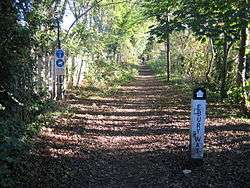Rickmansworth (Church Street) railway station
Rickmansworth (Church Street) railway station was a London and North Western Railway (LNWR) station in the town of Rickmansworth in west Hertfordshire, UK. Opened in 1862, it was the terminus of a 7.2-kilometre (4.5 mi) branch line which used to run from Watford. The station closed to passengers in 1952, although the line continued to be used as a goods line for some years after that. Church Street station has since been demolished.
| Rickmansworth (Church Street) | |
|---|---|
_Station_(geograph_2096337).jpg) Remains of Rickmansworth (Church Street) Station, photographed in 1972 | |
| Location | |
| Place | Rickmansworth |
| Area | Three Rivers |
| Coordinates | 51.6359°N 0.4654°W |
| Grid reference | TQ062941 |
| Operations | |
| Original company | Watford and Rickmansworth Railway |
| Pre-grouping | London and North Western Railway |
| Post-grouping | London, Midland and Scottish Railway |
| Platforms | 1 |
| History | |
| 1 October 1862 | Opened as Rickmansworth |
| 25 September 1950 | Renamed Rickmansworth (Church Street) |
| 3 March 1952 | Station closed for passengers |
| 2 January 1967 | closed for freight |
| Disused railway stations in the United Kingdom | |
| Closed railway stations in Britain A B C D–F G H–J K–L M–O P–R S T–V W–Z | |
A separate Rickmansworth station exists today about 0.7 kilometres (0.43 mi) north-west the site of Church Street station. It was opened 25 years after Church Street station and continues to serve both the London Underground Metropolitan line and the London to Aylesbury Line of Chiltern Railways.


The station was the terminus of the Watford and Rickmansworth Railway (W&RR), a business venture of the Whig politician, Robert Grosvenor, 1st Baron Ebury (1801–1893). It opened on 1 October 1862.[1] The line ran from Watford Junction to Rickmansworth with many small freight branches, the most notable of which ran to Croxley Green. Lord Ebury's plan was to extend this short branch line further south and to open a new railway route to Uxbridge Vine Street on the Great Western Railway's Uxbridge branch. However, the GWR withdrew its funding for the scheme and line was never extended.[2]
The line failed to operate at a profit, the W&RR ran into financial difficulties, and eventually the operation was taken over by the London and North Western Railway in 1881.
In 1923, under the London, Midland and Scottish Railway (LMS), the Rickmansworth branch line was converted to fourth-rail electric trains, along with the Watford Junction-to-Croxley Green line and the local service from Watford Junction to London Euston. The station was renamed from Rickmansworth to Rickmansworth (Church Street) on 25 September 1950.[1] It continued to be operated as a branch line from Watford by British Rail until the passenger service was withdrawn on 3 March 1952,[1] because many of the local passengers having been lost to intensive parallel bus services.
Rickmansworth (Church Street) railway station and the tracks leading to it continued to be used for goods services until 1967, when it was completely closed and the line cut back to one of the intermediate freight sidings. Today, the track has been removed and the platforms and station buildings have been demolished. The former site of Church Street station is now occupied by social housing; the premises of a builders' merchant now stands between the old station site and the canal.
The old track bed of the line to Watford is now the Ebury Way rail trail.
| Preceding station | Disused railways | Following station | ||
|---|---|---|---|---|
| Terminus | British Rail Rickmansworth Branch |
Watford High Street |
References
- Butt, R.V.J. (1995). The Directory of Railway Stations. Yeovil: Patrick Stephens Ltd. p. 197. ISBN 1-85260-508-1. R508.CS1 maint: ref=harv (link)
- Cooper, John (2014). "The Watford & Rickmansworth Railway". Rickmansworth Through Time. Amberley Publishing Limited. ISBN 9781445640839. Retrieved 20 January 2015.